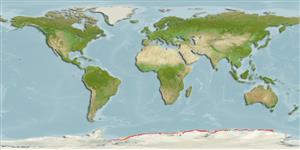>
Perciformes/Notothenioidei (Icefishes) >
Bathydraconidae (Antarctic dragonfishes) > Bathydraconinae
Etymology: Cygnodraco: Latin, cycneus = swan + Greek, drako = dragon (Ref. 45335).
Eponymy: Sir Douglas Mawson (1882–1958) was an Australian geologist and Antarctic explorer. [...] (Ref. 128868), visit book page.
More on author: Waite.
Environment: milieu / climate zone / rango de profundidad / distribution range
Ecología
marino demersal; rango de profundidad 110 - 300 m. Polar; 65°S - 79°S
Southern Ocean: Antarctic continental shelf. Probably circum-Antarctic.
Tamaño / Peso / Age
Madurez: Lm ? range ? - ? cm
Max length : 45.3 cm TL macho / no sexado; (Ref. 124149); 49.1 cm TL (female); peso máximo publicado: 404.20 g (Ref. 124149); peso máximo publicado: 404.20 g
Specimens larger than 26 cm TL were breeding. Spawning seems to take place in autumn or early winter. Feeds mainly on benthic and benthopelagic organisms such as fishes (Trematomus spp.), the decapod Crangon antarcticus, mysids, gammarid amphipod and polychaete worms (Ref. 5192). Minimum depth from Ref. 58018.
Gon, O., 1990. Bathydraconidae. p. 364-380. In O. Gon and P.C. Heemstra (eds.) Fishes of the Southern Ocean. J.L.B. Smith Institute of Ichthyology, Grahamstown, South Africa. 462 p. (Ref. 5192)
IUCN Red List Status (Ref. 130435: Version 2025-1)
Threat to humans
Harmless
Human uses
Pesquerías: sin interés
Herramientas
Special reports
Download XML
Fuentes de Internet
Estimates based on models
Preferred temperature (Referencia
123201): -1.8 - -0.2, mean -1.3 °C (based on 72 cells).
Phylogenetic diversity index (Referencia
82804): PD
50 = 1.0000 [Uniqueness, from 0.5 = low to 2.0 = high].
Bayesian length-weight: a=0.00062 (0.00040 - 0.00096), b=3.42 (3.29 - 3.55), in cm total length, based on LWR estimates for this species & (Sub)family-body (Ref.
93245).
Nivel trófico (Referencia
69278): 4.1 ±0.73 se; based on food items.
Resiliencia (Referencia
120179): Medio, población duplicada en un tiempo mínimo de 1.4-4.4 años (Fec=3,400-8,500).
Fishing Vulnerability (Ref.
59153): Moderate vulnerability (39 of 100).
🛈
